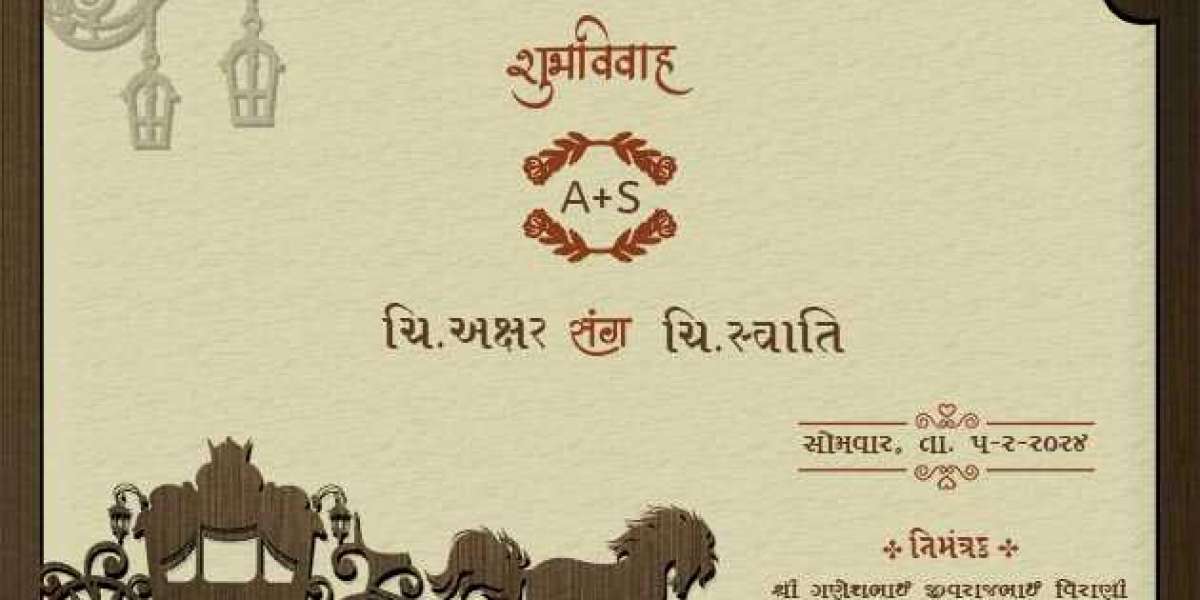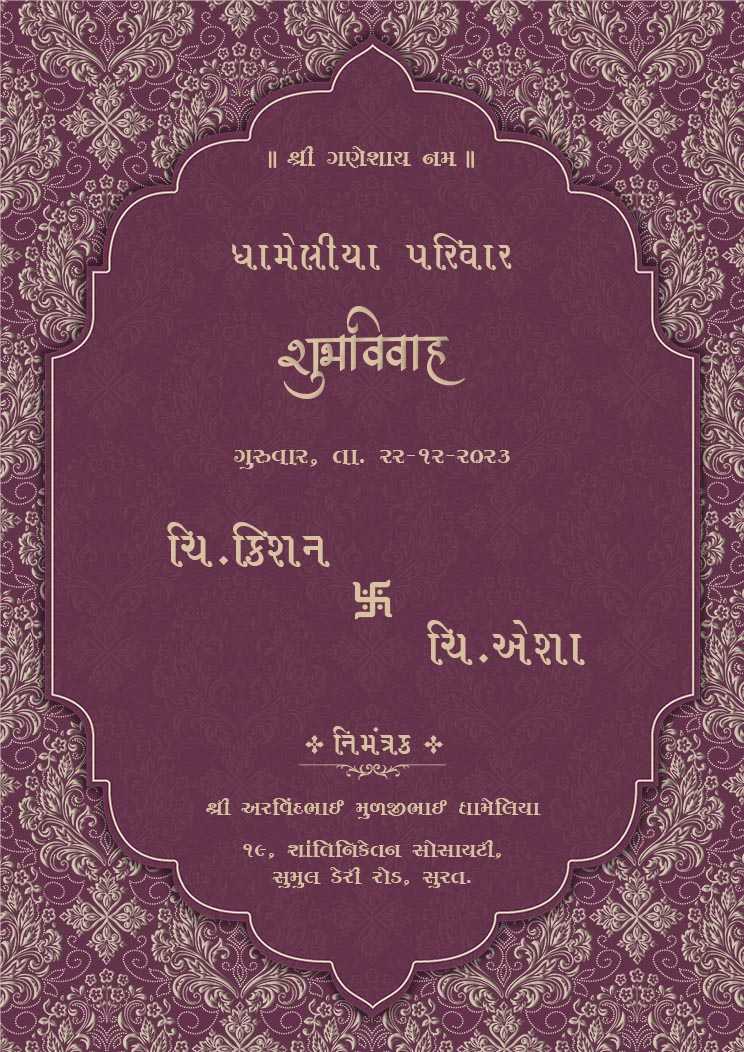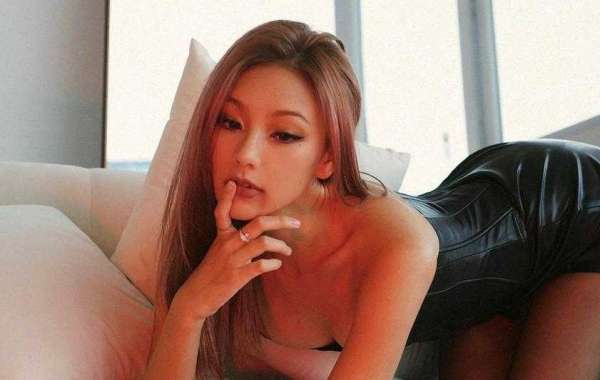Introduction:
Creating a Kankotri design involves carefully blending tradition with modern wedding planning to ensure every aspect of the celebration reflects the cultural richness of Gujarati customs. This guide will help you navigate through the process of designing a comprehensive template that serves as a roadmap for planning a seamless and memorable Gujarati wedding. From selecting the perfect Kankotri design to organizing traditional ceremonies and choosing attire, this introduction will lay the foundation for building a detailed, culturally authentic, and personalized wedding template. Whether you are planning a grand celebration or an intimate gathering, understanding how to create a Gujarati wedding template will ensure that every detail, from rituals to decor, aligns with the vibrant traditions and values of Gujarati culture.
The Role of the Kankotri in Gujarati Weddings
The Gujarati Kankotri is more than just a wedding invitation—it's a reflection of cultural values, familial bonds, and the spiritual significance of marriage. Some key roles of the Kankotri include:
- Announcing the sacred union: The Kankotri is the formal declaration of the marriage, often including blessings and tahuko (traditional wedding verses) that signify joy and celebration.
- Celebrating heritage: It incorporates motifs and symbols that are deeply rooted in Gujarati culture, such as peacocks, elephants, mangal kalash, and lotus flowers. These elements represent prosperity, purity, and harmony.
- Setting the tone: The design of the Kankotri is often a reflection of the grandeur of the wedding itself. A lavishly designed invitation hints at the opulence and excitement of the upcoming festivities.
- Emphasizing familial ties: Gujarati Kankotris often feature the names of family elders, signifying the union of not just the bride and groom, but two families coming together.
Modern Kankotri Design with a Contemporary Twist
With modern couples seeking more personalized and minimalist designs, Kankotri invitations are transforming. While traditional designs remain timeless, contemporary twists are gaining popularity for their clean lines, innovative layouts, and subtle elegance.
1. Minimalist Layout with Traditional Symbols
Modern Kankotris often adopt minimalist layouts that provide ample white space and clean typography, but still retain traditional elements like religious symbols or tahuko.
- Tip: Use a single, central symbol like a delicate mangal kalash or an understated om symbol paired with a modern sans-serif font. This combination of contemporary layout and traditional imagery creates a beautiful contrast that reflects both heritage and modernity.
2. Muted and Pastel Color Palettes
Traditionally, Gujarati Kankotris are bold and vibrant, with colors like red, maroon, and gold. However, modern designs are embracing muted tones such as pastels, soft gold, or even monochromatic schemes for a more sophisticated feel.
- Tip: Experiment with soft hues like blush pink, mint green, or dusty blue paired with gold accents. These colors bring a modern, elegant flair without losing the essence of a celebratory occasion.
3. Geometric Patterns with Cultural Motifs
While traditional invitations use floral and paisley patterns, modern designs are incorporating geometric shapes with subtle nods to cultural symbols. This provides a sleek, stylish edge to the Kankotri.
- Tip: Combine geometric borders or abstract shapes with smaller traditional motifs like lotus flowers or elephants to maintain a connection to cultural heritage while keeping the design fresh and modern.
4. Typography: Mixing Tradition with Modernity
Modern Kankotri designs often feature a combination of classic script fonts and sleek, modern typography. This provides a contemporary feel without losing the elegance associated with wedding invitations.
- Tip: Use a simple serif font for the main content, and accentuate names or headings with a traditional Gujarati script or calligraphy. This blend of old and new creates a visual hierarchy that enhances the overall design.
5. Incorporating Personalization and Storytelling
Couples today want their Kankotri to tell their story. Personal touches like the couple's favorite quotes, a meaningful illustration, or even a short narrative about their love story are increasingly popular in modern invitations.
- Tip: Include a small section in the Kankotri for a personal note or a meaningful tahuko that resonates with your journey. This adds an emotional and intimate layer to the invitation.
6. Eco-Friendly Materials
With sustainability becoming a priority, many couples are opting for eco-friendly paper and printing techniques. Using recycled paper or materials like seed paper not only reflects modern values but also adds an earthy, natural element to the Kankotri design.
- Tip: Choose high-quality, eco-friendly paper for a luxurious yet sustainable feel. Consider including a note about the material’s sustainability to showcase your commitment to the environment.
Tips for Creating the Perfect Modern Kankotri Design
Maintain a Balance Between Modern and Traditional
While modern aesthetics can give your Kankotri a chic, updated feel, make sure to incorporate traditional symbols or verses to honor your cultural roots.Focus on Simplicity
A modern Kankotri doesn’t need to be overly ornate. Opt for simple, clean designs that allow the content to shine. Minimalist designs are not only timeless but also easier to read.Don’t Overlook the Details
Elements like embossing, foil stamping, and laser-cut designs can add an elegant touch to a modern Kankotri. Subtle details in the paper quality, fonts, and finishes make a huge difference.Include Cultural Symbols with a Modern Interpretation
Incorporating cultural symbols in a subtle way can enhance the beauty of a modern Kankotri. For example, a small peacock feather or paisley motif in gold foil can add just the right amount of tradition.Consider Digital Invitations
Many couples are opting for digital versions of their Kankotri. A well-designed digital invite with interactive elements can be just as impactful as a physical card, especially in today’s digital age.
Conclusion: Honoring Tradition with a Modern Flair
Creating a modern Kankotri design is about finding the perfect balance between timeless traditions and contemporary trends. By embracing minimalist layouts, innovative color schemes, and subtle cultural motifs, you can design a Kankotri that is elegant, personal, and reflective of your unique style.
The Gujarati Kankotri tahuko and symbols will always hold a special place in these designs, reminding us of the cultural heritage that underpins every wedding celebration. With careful thought and attention to detail, your Kankotri can set the tone for a wedding that honors both your traditions and your modern values.





